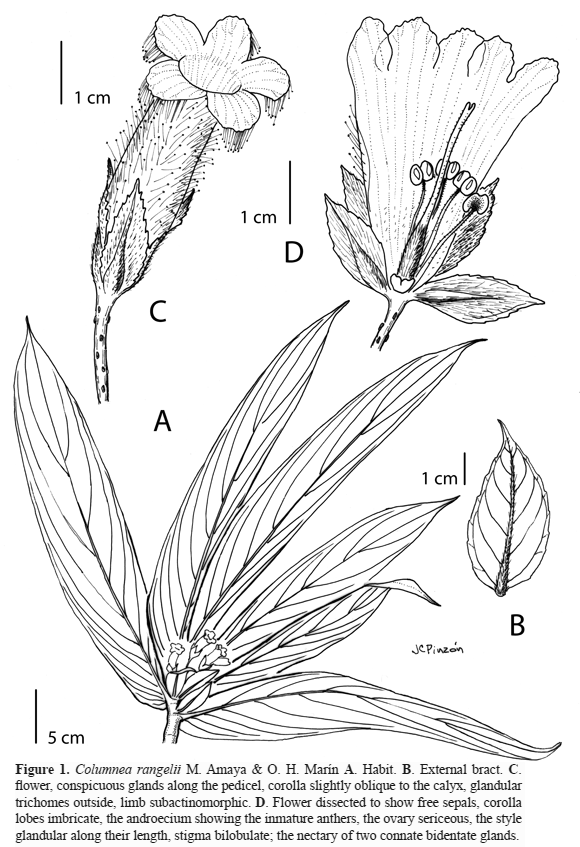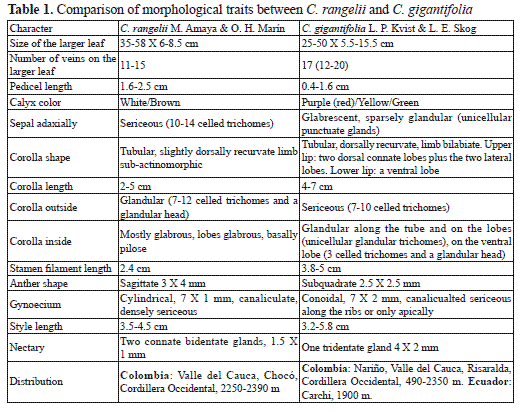Publicado
COLUMNEA RANGELII (GESNERIACEAE), A NEW SPECIES FROM THE SERRANÍA DE LOS PARAGUAS IN THE COLOMBIAN ANDES
MARISOL AMAYA-MÁRQUEZ
OSCAR HUMBERTO MARÍN-GÓMEZ
Instituto de Ciencias Naturales, Universidad Nacional de Colombia, Apartado 7495, Bogotá, Colombia. mamayam@unal.edu.co
Carrera 15 calle 12 N. Armenia, Quindío. Universidad del Quindío.oshuman@gmail.com
ABSTRACT
A new species of Columnea belonging to the section Collandra (Gesneriaceae) from La Serranía de los Paraguas in the Department of Valle del Cauca (Cordillera Occidental), Colombia, is described and illustrated.
Key words. Collandra, Columnea, Colombia, Flora of Colombia, Gesneriaceae, Serranía de Los Paraguas.
RESUMEN
Se describe e ilustra una especie nueva de Columnea perteneciente a la sección Collandra (Gesneriaceae). La nueva especie se encontró en La Serranía de los Paraguas, en el departamento del Valle del Cauca (Cordillera Occidental), Colombia.
Palabras clave. Collandra, Columnea, Colombia, Flora de Colombia, Gesneriaceae, Serranía de Los Paraguas.
Recibido: 27/02/2012
Aceptado: 15/05/2012
The Serranía de Los Paraguas is considered a strategic ecosystem with global priority for the conservation of biodiversity. It is part of the corridor system of mountains connecting Parque Nacional Natural Orquídeas - Farallones de Citará - Cerro de Caramantá - Cuchilla del San Juan - Macizo del Tatamá - Serranía de los Paraguas, all of which are part of the larger biogeographical Choco region. The Natural Reserve of Cerro El Inglés is a place with the highest records of endemism and biodiversity for the Serranía de los Paraguas, especially in the flowering plant families: Orchidaceae, Rubiaceae, Ericaceae, Melastomataceae, Araceae and Gesneriaceae (Silverstone-Sopkin & Ramos-Pérez 1995, Corporación Serraniagua (informe 2006, ined.). The reserve with 355 hectares and with a maximum elevation of 2400 m, harbors the montane wet forest ecosystem from which new species have been described for the flora of Colombia (Silverstone-Sopkin & Ramos-Pérez 1995, Clavijo & Clark 2010).
It is urgent to describe and understand the biodiversity patterns of the "hot spot" regions to implement effective plans to conserve the dazzling number of species present in those areas. In this paper we make a small contribution to this task reporting and describing a new species of Columnea belonging to section Collandra. The new species is assigned to section Collandra on the basis of the presence of two dorsal nectary glands and for having a vegetative shoot with the "fern-frond" physiognomy (Wiehler 1983), a feature that has been relevant to recognize species of this section (Kvist & Skog 1993). Additionally, the vegetative traits of the new species are identical to those of C. gigantifolia described by Kvist & Skog (1993) within section Collandra.
Columnea rangelii M. Amaya & O. H. Marín sp. nov. Figure 1 and Figure 2.

TYPE: COLOMBIA: Valle del Cauca: municipio El Cairo, vereda El Brillante, natural reserve Cerro del Inglés, 2250–2350 m, 21 Mar. 2011, O-H. Marín-Gómez & D. A. Gómez-Hoyos. 5 (Holotype: COL). Columnea rangelii differs from C. gigantifolia by having corollas with limb subactinomorphic.
Suffrutescent climber 0.5- 2 m high. Stem subterete, 0.5- 1.3 cm, green-brown, scarcely pilose; internodes 1- 2.5 cm. Leaves opposite, strongly anisophyllous in a pair, coriaceous; larger leaf sessile; blade slightly asymmetrical, lorate, 35-58 X 6- 8.5 cm, base oblique, apex caudate, margin subentire, adaxially green, glabrous, abaxially red-purple, sparsely pilose on the blade, densely sericeous on the main vein, 11-15 veins on the larger side of the blade; smaller leaf sessile, narrow oblong, 2-2.5 X 0.5- 0.6 cm, base slightly oblique, apex attenuate, margin subentire, adaxially green, glabrous, abaxially red-purple, sericeous on the main veins. Inflorescencefasciculate, 3-5 flowers on the larger leaf axil; one external bract, lanceolate, 4.2-7 X 1.1- 2.5 cm, adaxially green, sparsely pilose, abaxially mostly purple, tomentose, margin serrulate. Flower pedicellate, pedicel 1.6- 2.5 cm, sericeous (8-10 celled trichomes), with prominent glands along its length. Calyx white or brown, sepals free, subequal, lanceolate to narrow elliptic, 1.8-2.9 X 0.4- 0.9 cm, adaxially sericeous (10-14 celled trichomes), abaxially densely sericeous (10-14 celled trichomes), margin serrate. Corolla yellow, tube slightly curved dorsally, 2- 5 cm long, basally 0.5 cm wide, at the middle 1.2 cm wide, before limb 1.3 cm wide, limb open 2- 2.5 cm wide; base slightly saccate 0.5 X 1 cm; limb subactinomorphic, lobes patent, rounded to obtuse, 0.4-1.1 X 0.5- 0.7 cm; corolla exterior surface glandular (7-12 celled trichomes and a glandular head), interior surface mostly glabrous, basally pilose. Androecium of 4 stamens, filament 2.4 cm, pilose, basally connate by 0.5 cm of their length forming a staminal blade, anther sagittate 3 x 4 mm, connective sagittate ca. 2.5 X 3 mm. Gynoecium with the ovary cylindrical, 7 X 1.5 mm, canaliculate, densely sericeous; style 3.5- 4.5 cm long, scabrous and glandular (unicellular trichomes); stigma bilobulate. Nectary of two connate, bidentate dorsal glands, 1.5 X 1 mm each.Fruit not seen. Seeds not seen.
Etymology. The species is named after Jesús Orlando Rangel Churio, to honor this Colombian scientist who has contributed to a great extent to the advance and understanding of the biological diversity in Colombia.
Phenology: Flowers have been recorded in the specimens collected in March and August.
Distribution: Colombia (Valle del Cauca, Chocó), 2250- 2390 m alt.
Representative specimens: COLOMBIA. Chocó: municipio San José del Palmar, 2390 m, Aug. 23, 1988, P. A. Silverstone-Sopkin et al. 4694 (CUVC).
Distinctive features: Columnea rangelii has a robust vegetative shoot with the larger leaf in a pair, sessile (up to 58 X 8.5 cm), completely red-purple on the abaxial side. The inflorescences are congested apically by the shortening of the internodes, with several flowers open at a time; the corollas of these flowers show an ample range in length (2- 5 cm) suggesting different stages of the floral phenology. The flower of C. rangelii is unique within section Collandra by having a corolla tube slightly recurvate with an ample subactinomorphic limb. This species is very similar to C. gigantifolia, and they can be distinguished by floral traits, where the difference is evident (Table 1, Fig. 2).
Columnea rangelii was found at night while sampling amphibians at the border of a ravine; however this species could not be found again in spite of an effort of 120 hours invested searching for it. In the same vein, the rarity of C. rangelii is confirmed from the study of herbaria specimens of Columnea from different herbaria, where only one of 1020 exsiccate corresponded to C. rangelii (paratype). This is suggestive that the species is rare and endemic to the Serranía de los Paraguas.
Columnea rangelii shares its habitat at Cerro del Inglés with: C. gigantifolia, a locally abundant species, C. archidonae, C. dictyophilla, C. dimidiata, C. fuschihirta, C. filipes, C. paraguensis, C. pedunculata, C. suffruticosa, C. tenella, Columnea sp nov.1, and Columneasp nov. 2. Although C. archidonae is currently under the synonymy of C. ericae, the name is considered as a distinct taxon (Amaya-Márquez et al. in prep.).
ACKNOWLEDGMENTS
To the National University of Colombia for the opportunity to do research. To Juan Carlos Pinzón for the elaboration of the drawings. To Philip A. Silverstone-Sopkin for kindly sharing pictures and data of the paratype specimen. To Diego Gómez for his help during the field trip. To two anonymous reviewers whose valuable comments help to improve the manuscript.
LITERATURE CITED
1. CLAVIJO, L. & J. L. CLARK. 2010. Drymonia droseroides (Gesneriaceae), a new species from the Pacific Andean Forest of Colombia. Selbyana 30: 190-194.
2. KVIST, L. P. & L. E. SKOG. 1993. The genus Columnea (Gesneriaceae) in Ecuador. Allertonia 6: 327-400.
3. SILVERSTONE-SOPKIN P. A. & J. E. RAMOS-PÉREZ 1995. Floristic Exploration and Phytogeography of the Cerro del Torrá, Chocó, Colombia. In: Biodiversity and Conservation of Neotropical Montane Forest. Churchill, S. P; H. Balslev; E. Forero & J. L. Luteyn. (Eds.). The New York Botanical Garden. New York. 169-186 pp.
4. WIEHLER, H. 1983. A synopsis of the Neotropical Gesneriaceae. Selbyana 6: 1-219.
Cómo citar
APA
ACM
ACS
ABNT
Chicago
Harvard
IEEE
MLA
Turabian
Vancouver
Descargar cita
Visitas a la página del resumen del artículo
Descargas
Licencia
Derechos de autor 2012 Caldasia

Esta obra está bajo una licencia internacional Creative Commons Atribución 4.0.
Aquellos autores/as que tengan publicaciones con esta revista, aceptan los términos siguientes:
- Los autores/as conservarán sus derechos de autor y garantizarán a la revista el derecho de primera publicación de su obra, el cual estará simultáneamente sujeto a la Licencia de reconocimiento de Creative Commons que permite a terceros compartir la obra siempre que se indique su autor y su primera publicación esta revista.
- Los autores/as podrán adoptar otros acuerdos de licencia no exclusiva de distribución de la versión de la obra publicada (p. ej.: depositarla en un archivo telemático institucional o publicarla en un volumen monográfico) siempre que se indique la publicación inicial en esta revista.
- Se permite y recomienda a los autores/as difundir su obra a través de Internet (p. ej.: en archivos telemáticos institucionales o en su página web) antes y durante el proceso de envío, lo cual puede producir intercambios interesantes y aumentar las citas de la obra publicada. (Véase El efecto del acceso abierto).























